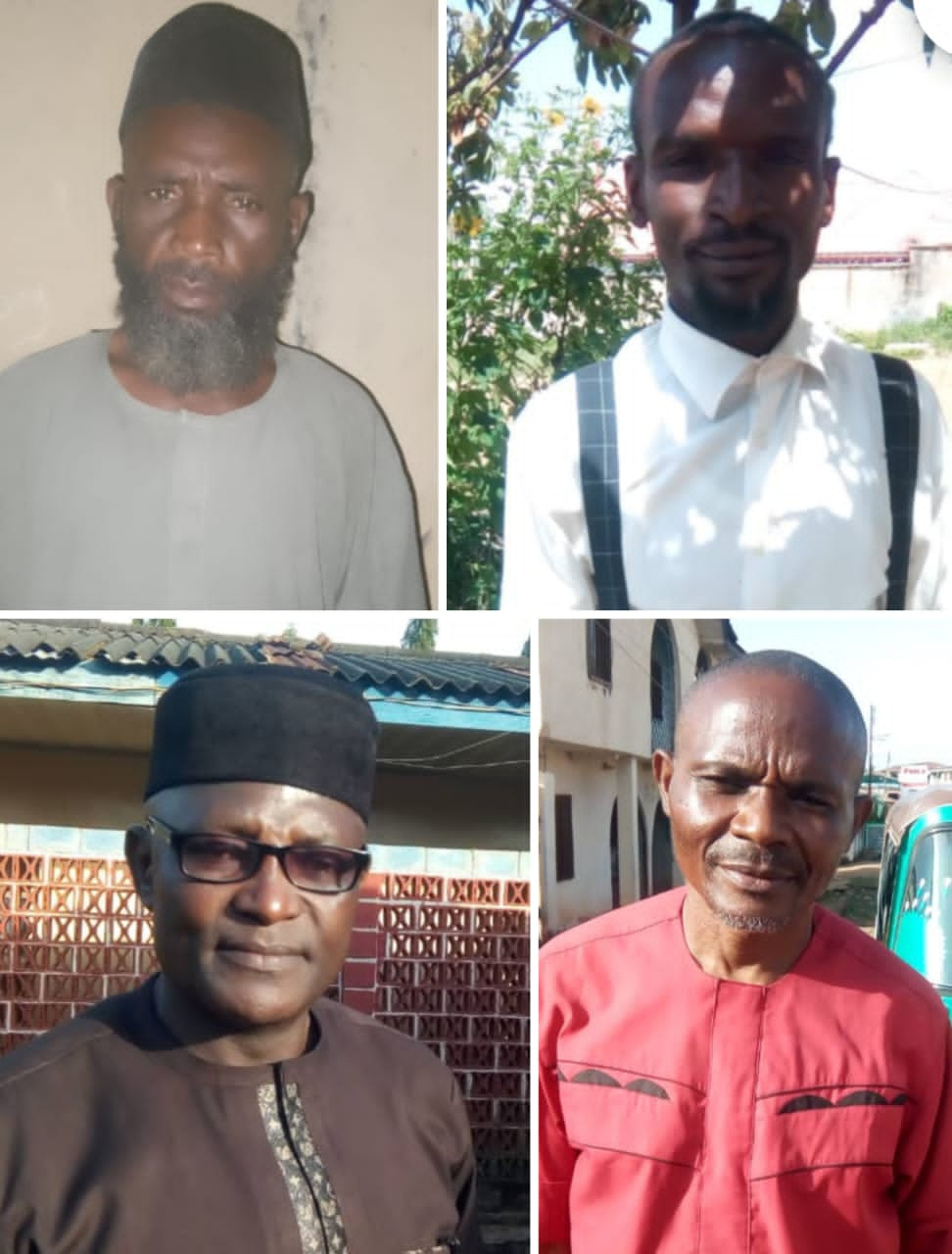Columns
Nneamaka: A Killer Graduate From Vom

Nneamaka: A Killer Graduate From Vom
By: Balami Lazarus
As we welcome back judges and members of the bar to yet another legal year in the judicial calendar and pray for more knowledge and wisdom in the dispensation of judgment, The title creates a tense atmosphere buried in a scary suspense environment like that of a thriller movie. Your adrenaline is high, and you are horror-struck. Your mind is automatically going back to those fearful chill-horror films of Dracula, Brotherhood of Satan, The Strangers, and Evil in the Dark you once watched as a young boy that gave you sleepless nights. However, what you are reading is not fiction, nor is it a make-believe story imagined and created by this writer; it is a true-life story that happened recently in Vom.
I have observed over the years in my relationship with the media that most are not doing well in follow-up stories. These media houses will quickly report and inform the public on matters relating to social ills, crimes, domestic violence, or child abuse perpetrated by persons with evil intentions, like the one in question, and many others, and that ends the story.
But this particular one will not go like other reportages without a follow-up to its logical legal conclusion with prayers that justice shall prevail as the matter is before a court of competent jurisdiction in Jos, where the alleged killer graduate is facing three counts of culpable homicide, cruelity to person, and voluntry causing hurt or grievous hurt by dangerous means punishable with death (Plateau State Penal Code Law 2017).
On a beautiful Friday, November 11, 2022, in a quiet, serene environment at the National Institute of Trypanamaosis (NIRT), staff quaters, a life was taken brutally and mercilessly with intense wickedness out of a young innocent girl, sending her six feet below the mother earth. Once lived in Vom, a horrible, unkind, and wicked killer graduate in the guise of a researcher, her content of character towards her innocent live-in house help, which ordinarily in the African family system the victim is equally her daughter, but the killer graduate relationship with the victim now deceased was a one-way traffic, this way for a shroud.
READ ALSO: https://newsng.ng/the-plight-of-farida/
Let me digress a bit in order to look at the biological composition of deoxyribonuclic acid (DNA) cells of natural hereditary species found in humans and animals. These cells contain certain behavioral genes perculiar in human beings passed from generation to generation as DNA genes. Therefore, I reasonably believe these genes had been passed to the killer graduate, either paternal or maternal, which manifested in the callous manner in which she mishandled the young girl with nefarious intentions that led to her death. Before her painful death, the innocent girl never enrolled in school, nor did she engage in any trade of her choice.
What the poor young girl got was restlessness, tiring, choking house chores 24/7, and donkey beatings with little or no food to eat at most times until she died. Now let us know who the killer graduate is. She is none other than Mrs. Nneamaka Finans Nwachukwu, the daughter of one Dr., and Mrs. Ralph Uzoigwe a mother of two daughters, a graduate of microbiology from Nasarawa State University (2011). Nneamaka is married to Mr. Finans Uwachukwu, a quiet gentleman, according to reliable sources.
The abused and brutalized young girl is Margaret Joshua, who was 11 years old and from Kebbi State. Dependable sources said that Mrs. Finans has always been in an unhealthy relationship with her colleagues and neighbors, including her friends; the worse of it was with her subordinates at the workplace. We, as media, are looking forward to the continuation of the case against the defendant, Nneamaka.
Balami, a Publisher and Columnist (8036779290)
Nneamaka: A Killer Graduate From Vom
Columns
The Plights of ‘Certificate Graduates’ Who Read and Refused to Study (2)

The Plights of ‘Certificate Graduates’ Who Read and Refused to Study (2)
By: Balami Lazarus
This is the conclusion of the work on the subject above.
Universities are the highest level of academic teaching and learning, where students are trained in different educational courses and awarded degree certificates. Universities are also centers of research, science, technology, and innovation. Therefore, a qualified and competent university graduate is a universal product who is supposed to stand tall and proudly defend his learning anytime, anywhere.
The bastardization of university degree certificates is aided and abetted by both academic and non-academic staff who probably might have been employed through the back doors. Likewise, many of their students. You can now freely connect the chain of corruption with its forward and backward leakages anchored in our university systems: recruitment and admission. Tell me, don’t you think that grades and certificate racketeering are more feathered?
The craze and demands for degree certificates in the labor market by employers have raised and increased the graduations of ‘certificate graduates’ at all costs by all means over the years. I heard of a story, which I am yet to verify, that a certain private university once certified and graduated many first-class graduates. For me, this is not an academic progress but a questionable act. Similarly, if you were to put them to the test in their various courses of study, you would concur with me and ask how it is possible to have such a number of supposedly first-class graduates.
The plights of ‘certificate graduates’ are self-inflicted by students who are not the serious type by all standards. If you are to do a background check on them and schools attended before their admission into the university of their choice, the story you will hear about them will definitely attract vultures.
This problem has since permeated faculties, departments, schools, and colleges of our universities where ‘certificate graduates’ are produced. Some universities have become exchange floors where you exchange your flaws for a degree certificate, which shall be given to you. And that marks the plights of such graduates.
Most of them are not helpful to themselves, always dependent on others for things you expect university graduates should know and do.
My work experience as a one-time school administrator of a private school in Narabi, Bauchi State, where I had related to, associated with, and managed ‘certificate graduates’ of the Corps on National Service (NYSC). Working with some of them was a woe of tales, because teaching was their primary duty. I pitied them.
That one experience has given me an insight into how some universities are churning out bad graduates for public recruitments.
These manners of graduates cannot work or attempt to work with good results-oriented corporate organizations where your productivity is the ladder of upward mobility.
Public and private educational institutions should join hands with relevant authorities and stakeholders to formulate a template for a sound and credible working system where students will be properly and genuinely certified as graduates.
Balami, a Publisher/Columnist 08036779290
The Plights of ‘Certificate Graduates’ Who Read and Refused to Study (2)
Columns
The Plights of ‘Certificate Graduates’ Who Read and Refused to Study (1)

The Plights of ‘Certificate Graduates’ Who Read and Refused to Study (1)
By: Balami Lazarus
It’s the hope and aspirations of many young Nigerians, male or female, to acquire and have a sound basic academic qualification, preferably a degree, that he/she can reasonably defend in character and in learning. And productively add value to his society and self.
As a certified graduate with a degree certificate? Are you competent to defend your educational qualification at any point in time? A competent university graduate has the knowledge and intellectual capacity to speak, defend, and be proud of his academic discipline. Such graduates are well baked.
I am not in any way undermining other good graduates from other tertiary educational institutions who are capable and able to be called graduates.
Why am I specific with university graduates? It has to do with my experiences in recent times with some of them that have no measure of basic knowledge of their course of study, talk less of general knowledge. This class of graduates lacks knowledge and understanding of their academic discipline; they are behind in confidence, basking in timidity. They are always found wanting in multiple dimensions as so-called graduates. What a shame!
Now let’s begin to see the plights of a ‘certificate graduate.’ What is your name, young man? My name is Takulash. What did you study? I read political science. You read, not studied, yes sir. No wonder you cannot defend your degree certificate and its class? This is one scenario that is common in an interface with a ‘certificate graduate.’
I was privileged to be on interview panels where I engaged graduates both written and orally. Of late, many university graduates are only certificate carriers without simple knowledge of what they claimed to have studied. What has contributed to these problems? This question has been on the lips of concerned citizens and stakeholders. Some said there is a fall in standard. Others hinged on corruption practices in our educational institutions. Whatever the challenges or
the problems are? I will attribute it to the negligence of our educational system, corruption, and the proliferation of private universities in Nigeria. Basically I will say for business purposes.
Another major reason that has brought up the issues of ‘certificate graduates’ is the poor educational backgrounds of pupils, right?
from primary schools that have been neglected and left unattended, the case of public primary and secondary schools that are feeders to higher educational institutions are not cared for. With a poor educational background, how can students perform to the expectations of the universities and be productive to society as proud and competent university graduates?
My heart bleeds whenever I interface with such graduates that cannot justify their degree certificates. They are the ones that just passed through the ivory tower without any meaningful academic/intellectual gains. Many of them were corruptly aided by their teachers and supported by their parents, a common factor in most private universities where academic programs have been commercialized, including grades for monetary exchange.
These undergraduates cannot stand on their own. They are always looking for someone to do their academic work/assignments. Are you aware that ‘certificate graduates’ cannot fill out a simple form or apply for a job and/oranswer general knowledge questions in an interview?
In fact, ‘certificate graduates’ cannot withstand the challenges of society and her labor market. Many of them are not brilliant but are full of strange and criminal behaviors, and they can do anything to obtain their certificates. They have refused to allow the university to pass through them.
The Plights of ‘Certificate Graduates’ Who Read and Refused to Study (1)
Columns
Public Mouthpiece, Politicians, and Grassroots Mobilizers: Holding Leaders Accountable for Good Governance and Peaceful Coexistence

Public Mouthpiece, Politicians, and Grassroots Mobilizers: Holding Leaders Accountable for Good Governance and Peaceful Coexistence
By: Balami Lazarus
For some time NEWSng has been waving aside the idea of writing on these popular patriotic individuals who are public mouthpiece politicians and grassroots mobilizers that have taken upon themselves to contribute their quota consistently on radio by holding elected leaders accountable and demanding good governance and peaceful coexistence on the Plateau and in Nigeria at large.
It is interesting to know if a media known for featuring and reporting positive developments should allow such important contributions to our democracy with clear objectives for good governance to go down the drain.
Therefore, these men are like the old English musketeers famous for their bravery and professional acts of protection of kings in medieval Europe. These respected individuals are for the public interest, advocating for good governance at all levels through their voices.
They are public mouthpieces, spokesmen for and on behalf of the public who are always calling the attention of elected leaders to challenges faced by the citizens who voted them into power in the political democracy on the Plateau through some radio programs.
The contributions of these patriotic citizens for holding our leaders accountable for good governance in order to make Nigeria better serve as the lighthouses of our democratic growth and development.
If you were to listen to them, you would agree that they are passionate about good governance/dividends of democracy and peace on the Plateau and in Nigeria. They are not critics; they don’t attack, but their actions and opinions/views are raw and painful but are the truth that cannot be denied because they are necessary for the government and other leaders who need to consider them and begin to act to bring developments for the citizens.
NEWSng decided to limit this work to only five in spite of numerous contributors to the radio programs. Musa Kalu, Ada Onugu, Comrade Dadong Antibas, Hon. Omenaka Jude Sat, and Sadiq Umar, whose voices are the true representations of the grassroots. Their voices are cries of the Nigerian masses for dividends of democracy. Ultimately they are holding democratically elected leaders accountable in the present democratic dispensation.
Speaking to them individually on why they are passionate about holding elected leaders accountable. However, they spoke from different angles of developments. Ironically, they are all on the same page demanding good governance and peaceful coexistence among the Nigerian citizens.
Musa Kalu is always on the path of peaceful coexistence without any sentiments. ‘As a Nigerian, I am for peaceful coexistence, progress, and development. Nigeria belongs to all of us in respect of religion, ethnicity, and geographical location. Hon. Jude Sat said that as a public mouthpiece, they will not close their eyes where the government is not doing the needful. ‘I will continue to speak for a better Plateau and Nigeria and for the future generations.’
These individuals are refined politicians in their own right with a strong political hold on their wards/communities. Reliable sources have it that Governor Caleb Manasseh Mutfwang received bulk votes in Jenta/Apata wards, among other wards in Jos, because of the handiworks of some of the public mouthpiece politicians and grassroots mobilizers.
On security bedeviling the state and the country at large, they unanimously said that unless and until the government takes decisive actions on the security challenges, there will be no good governance.
Dadong Antibas said, ‘We will continue to speak and hold our leaders accountable at all times. I have received threats, but that has not stopped my voice…. I have been speaking on state and national issues for years.
Furthermore, Sadiq Umar said that citizens of the state have come to confide in them to speak and call the attention of the government and other elected leaders to their plights. Holding our leaders responsible and accountable…is my responsibility, including you.
Attempts to meet and speak with Ada Onugu failed. However, investigations revealed that their voices are meant to check the activities of government and elected leaders on the Plateau. Their hold on their wards/communities as public mouthpiece politicians and grassroots mobilizers is laudable. Thus, elected leaders and aspiring politicians on the Plateau are beginning to align and key into their popularity at the grassroots.
They all acknowledged the wonderful works of Governor Caleb Manasseh Mutfwang for his efforts in providing dividends of democracy through good governance.
Public Mouthpiece, Politicians, and Grassroots Mobilizers: Holding Leaders Accountable for Good Governance and Peaceful Coexistence
-

 News2 years ago
News2 years agoRoger Federer’s Shock as DNA Results Reveal Myla and Charlene Are Not His Biological Children
-

 Opinions4 years ago
Opinions4 years agoTHE PLIGHT OF FARIDA
-

 Opinions4 years ago
Opinions4 years agoPOLICE CHARGE ROOMS, A MINTING PRESS
-

 News2 years ago
News2 years agoEYN: Rev. Billi, Distortion of History, and The Living Tamarind Tree
-

 News7 months ago
News7 months agoFAILED COUP IN BURKINA FASO: HOW TRAORÉ NARROWLY ESCAPED ASSASSINATION PLOT AMID FOREIGN INTERFERENCE CLAIMS
-

 ACADEMICS2 years ago
ACADEMICS2 years agoA History of Biu” (2015) and The Lingering Bura-Pabir Question (1)
-

 Columns2 years ago
Columns2 years agoArmy University Biu: There is certain interest, but certainly not from Borno.
-

 Opinions2 years ago
Opinions2 years agoTinubu,Shettima: The epidemic of economic, insecurity in Nigeria




